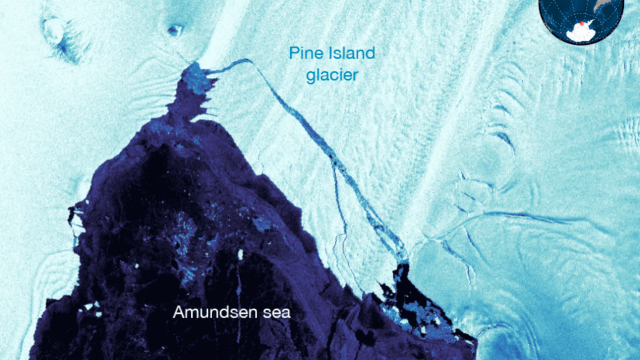Satellite images taken this past weekend show a new 267km
Satellite image taken of the new iceberg on 24 September 2017. (Image: Sentinel1)
Pine Island Glacier (PIG) is the fastest melting glacier in Antarctica — one that’s responsible for a quarter of the frozen continent’s ice loss, a whopping 45 billion tonnes of ice each year. Satellite images taken from September 23 to 24 show an open-water gap emerging between the ice shelf and the iceberg, which is about four times the size of Manhattan (267km
The new iceberg appears to be quite unstable, producing a batch of smaller icebergs as it slowly drifts out to sea. The new berg is not nearly as big as the one produced by the Antarctic Peninsula’s Larsen C ice shelf a few months ago — an enormous chunk of ice that measures about 5800km2).
On Sunday, satellite observation specialist Stef Lhermitte at Delft University of Technology in the Netherlands posted a Sentinel1 image of the new PIG iceberg.
Breaking news from Pine Island Glacier, which lost 267km2 of icebergs today, after the internal crack resulted in a large calving event 1/n pic.twitter.com/sLwGTyNTfC
— Stef Lhermitte (@StefLhermitte) September 23, 2017
Gizmodo contacted Christopher A. Shuman, a research scientist within the Cryospheric Sciences Laboratory at NASA Goddard Space Flight Center, who confirmed the break using the MODIS and Landsat 8 satellites.
The area drained by PIG encompasses approximately 10 per cent of the West Antarctic Ice Sheet, making it a critically important geological feature in terms of its contribution to sea level rise. This is now the third major calving event produced by this ice stream in four years, the others happening in 2013 (652km2) and 2015 (582km2).
“But it isn’t the size of the bergs that are the main issue,” Shuman told Gizmodo. “It is the overall progressive retreat of the ice front with calving losses in 2013, 2015 and 2017, which is pretty rapid retreat for any very large glacier especially one this far south in Antarctica. With the first big loss in 2001, this is not a good sign for sure.” To which he added, “This is not as large a loss as in 2013 but it is a further retreat from what was a pretty stable ice front in at the beginning of this century.”
Shuman also confirmed that the rifts are forming in the centre of the glacier and extending out toward the edges. This means that the rifts are forming far inland, likely the result of warm ocean water rubbing against the base of the glacier. This may explain why the calving events are happening with increased frequency (the speed of the glacier’s flow towards the sea is increasing, and it’s now moving at about 4km per year), and why PIG appears to be thinning (the rate of thinning has quadrupled since the mid 1990s). If this current rate of thinning continues, the entire main trunk of the glacier could be afloat in about 100 years.
The West Antarctic ice sheet is separated from the ocean by a series of large glaciers, PIG included. These glaciers are holding back tremendous volumes of ice, but as this recent calving event demonstrates, perhaps for not much longer.
